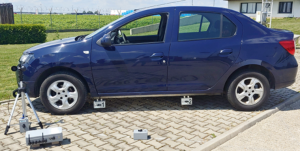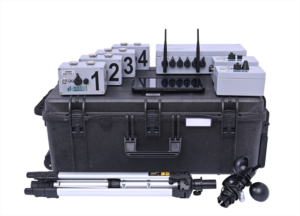HOW IT OPERATES:
Magus HBD operates by sensing and processing both intentional (e.g., movement) and involuntary (e.g., heartbeat) vibrations generated by the human body. These vibrations are transferred to the vehicle or container and then picked up by the highly sensitive sensors equipped within the Magus HBD system. These human being detection sensors are magnetically affixed to different areas of the vehicle or container’s chassis, while additional sensors are placed on the ground in proximity to the vehicle or container. Upon attachment and activation, these sensors convert vibrations into electrical signals, which are subsequently transmitted wirelessly to the Magus HBD Processing Unit (Magus HBD-PU). Inside this processing unit, the acquired signal is meticulously analyzed using a sophisticated AI-based algorithm.
MAGUS HBD PRODUCT:
The Magus HBD software application allows for the visualization of processed signals from all the sensors and the detection results through a user-friendly interface. The system only triggers an audible alarm when the AI-based algorithm identifies a vibration pattern indicative of a human being’s presence inside the vehicle or container under scrutiny, minimizing false alarms.

MAGUS HBD COMPONENTS:
- – Human being detection sensors (minimum 2 sensors, expandable up to 6 sensors with 1 spare)
- – Ground vibration detection sensors (minimum 1 sensor, expandable up to 2 sensors with 1 spare)
- – Wind speed sensor
- – MAGUS HBD processing unit
- – Portable rugged device (tablet) running the MAGUS HBD software application
- – MAGUS HBD software application
- – Battery charger for the MAGUS HBD processing unit and wireless sensors
- – Transportation and storage case

COMMON APPLICATIONS:
The Magus HBD system is typically deployed in various security-sensitive areas, including:
- – Border crossing points
- – Penitentiaries
- – Military units
- – River and seaports
- – Road checkpoints for vehicles
- – Critical infrastructure
BENEFITS:
The Magus HBD system offers several advantages, such as:
- – Precise detection of concealed individuals within vehicles or containers
- – Swift scanning process
- – Reduced occurrence of false alarms
- – User-friendly interface with visual and audible alerts
- – Seamless integration into existing checkpoints
- – Portability for added flexibility
- – Operational cost-effectiveness, necessitating fewer personnel, infrastructure, and training
- – Enhanced security and detection efficiency